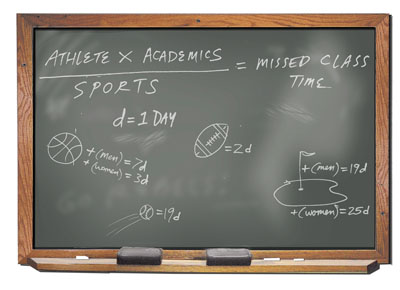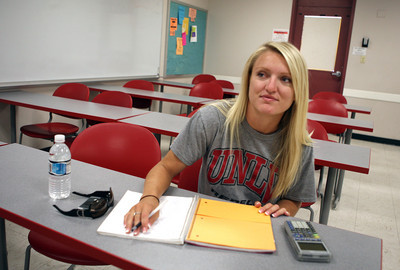Academics require balancing act
A mechanical problem with a chartered flight forced the UNLV women's basketball team to scramble to get to San Diego State.
The Lady Rebels managed to book a commercial flight for the late-February game but had to bus back to Las Vegas and arrived on campus at 4 a.m.
Junior Brittany Halberg didn't bother to drive home. She slept in the team room at Cox Pavilion and then woke up in time to attend three classes from 8 a.m. to 12:45 p.m., went through a basketball video session from 2 to 3, practiced until 5 and then finally arrived home to study and relax before going to bed at about 10:30. Then Halberg returned the next morning at 5:30 for a ride to the airport and a trip to Texas Christian in Fort Worth, Texas.
"It was a long week, to say the least," Halberg said.
So much for the glamour of being a college athlete. The truth is, UNLV athletes face greater time demands than fellow students when it comes to academics.
UNLV provides student-athletes with resources to do well in the classroom. Tutors are made available, an attendance policy has been instituted, coaches schedule games to diminish lost class time, and study halls are mandatory for some athletes.
UNLV has adopted a policy, which was a major step toward cutting down on missed class time. In 2004, almost all Friday classes were eliminated.
The result is that most UNLV athletes don't miss a lot of class time. Only baseball and men's and women's golf registered double-digit days of missed class time this past academic year.
ATHLETES MUST DO THEIR PART
Sophomore volleyball player Jessica Walters, UNLV female scholar-athlete of the year, makes out a personal schedule weeks in advance that includes, games, practices and classes to see how she best can use any free time.
Even her offseason is grueling. Her typical Tuesday this past semester included three morning classes, a trip to the trainer's room and practice. With no time for a lunch break, she sometimes ate in class.
"I planned in high school a little bit," said Walters, a journalism major with a 3.96 grade-point average. "But when it comes to Division I sports, it's a whole other level, and school is a whole other level."
Senior tennis player Elena Gantcheva found herself mentally and physically drained by the weekend, when most of her matches occurred. Morning classes were followed by practice and private hitting in the afternoon. Then study at night and an attempt to cram in a few hours of sleep.
On Saturdays, Gantcheva would arrive at the court at 8:30 a.m. for matches that would begin 90 minutes later and wouldn't get home until 5 p.m.
"It's hard to go home and study," said Gantcheva, who did plenty in carrying a 3.5 GPA as a hotel administration major.
The burden on some athletes is even greater. While some take the more difficult required classes when they are out of season, or sign up for classes with more homework than tests while in competition, other athletes don't have that luxury.
Junior soccer player Brie Kuhne is a kinesiology major who is required to take mostly four-credit (as opposed to three-credit) classes that come with 21/2-hour labs.
"Instead of three classes, it's essentially six classes," Kuhne said.
One lab this recently completed semester lasted until 9:45 p.m.
"When you factor in having tests and quizzes every week for classes and finding time to rest and study, it's hard," said Kuhne, who has a 2.98 GPA.
COACHES TRY TO CHART PROGRESS
Coaches stay on top of academic progress with periodic grade checks. Study halls are required for some athletes. Papers and tests often are handled before athletes go on trips, but they sometimes finish assignments on time via e-mail, as well as some exams.
Track coach Yvonne Scott-Williams requires study hall for all of her athletes who don't carry at least a 3.2 GPA.
Many coaches establish strict rules for incoming freshmen. Those in cross country are scheduled for eight hours of study hall per week. Women's soccer players also take that amount, but those who achieve at least a 3.0 GPA their first semester have to show up for only five hours the spring term. Those who continue to maintain a 3.0 no longer are required to take part in study hall.
Travel plans are made with the idea of keeping lost class time to a minimum.
Football is one of four teams that charters flights, allowing the team to return to Las Vegas immediately after games. Men's basketball and men's golf also charter flights, as does women's basketball on a more limited scale.
Football also benefits from a television deal that guarantees just about every game will be played on Saturday, making missed class time a nonissue.
"I think one thing people don't take into account is had we stayed with ESPN, we would've been playing on Tuesday, Wednesday and Thursday nights," football coach Mike Sanford said.
Many teams, such as volleyball and men's basketball, leave on afternoons following classes.
Cross country competes on Saturdays only. Most track meets are on weekends, and many are in California, so the team hops on a bus following Thursday classes.
Women's soccer coach Kat Mertz said a fall sport like hers faces the extra burden of trying to acclimate freshmen to college life while the team is in season.
It's easier for freshmen baseball and softball players who don't start playing until spring to get used to college life. Athletes who participated in fall sports get thrown into the fray right away, Mertz said.
MISSED CLASS TIME INEVITABLE
Despite many efforts, missed class time is inevitable, especially when it comes to UNLV's golf teams.
The men's team missed 19 class days this season and 21 the year before. The women missed 25 days in the 2007-08 season and 22 a year ago.
Both teams, particularly the women, are forced to play a lot of weekday tournaments because golf courses want to be available for paying customers on the weekend.
"I'm really lucky in the fact that this group of kids are really dedicated students as well as golfers," said women's golf coach Missy Ringler, whose team GPA is 3.03, including 3.25 in the spring semester. "We don't have to harp on them to use their time wisely and study."
Men's golf coach Dwaine Knight includes holidays when making out the schedule. He times the trip to Hawaii with Presidents Day.
Many three-round tournaments also are played over two days, with 36 holes on one day.
"We try to use as much imagination as we can to keep (missed) days down and be creative," said Knight, whose team maintained a 3.0 GPA or better for nine consecutive semesters through last fall.
Coaches in all sports agree strong academic results begin with recruiting good students.
"I think it tells you their commitment and work ethic," volleyball coach Allison Keeley said. "You can have a great athlete who's a C-student, but maybe they aren't analytical or don't do the smaller things that an A- or B-student does. They might not do the extra things you need."
But coaches also say it's important to look beyond the high school GPA. Some athletes aren't natural students, but they work hard in school and can bring those same qualities to a college team.
"There are different players with different abilities in the classroom," men's basketball coach Lon Kruger said. "It's more significant to have an interest to do well and an interest in realizing you need to do everything possible to perform."
ATTENDANCE POLICY ENFORCED
While strong efforts are made to help athletes be at their best academically, measures also are in place for those who stray.
The athletic department created an attendance policy about a year ago and enforced it beginning this academic year. A first unexcused absence results in a meeting with the respective coach and a two-hour study hall the following week. By the fourth miss, an athlete faces a possible meeting with athletic director Mike Hamrick as well as potential suspension and/or loss of scholarship.
Jeff Higgins, director of student-athlete academic services, said three or four athletes were suspended for a game in the fall, but he didn't have spring figures.
Higgins and five other advisers make random visits to see if athletes are in classes. That cuts down on athletes trying to cut a 300-student auditorium class. He said the number of unexcused absences dropped from roughly 300 in the fall semester to about 230 in the spring.
"Any change is gradual, and this is the direction we're going in," Higgins said. "A couple of kids get in trouble, and the rest get the message."
Coaches also try to get the message to their athletes that going pro in sports is unlikely. The odds are low enough in football and men's and women's basketball, and they're miniscule in the other sports.
"As a coach, you're judged on wins and losses, but we take pride when they do well in school," men's soccer coach Mario Sanchez said. "Unfortunately in this day and age, most people and the media forget at the end of the day they are college students."
Contact reporter Mark Anderson at manderson@reviewjournal.com or 702-387-2914.
A DAY IN THE LIFE A day in the life of two top UNLV student-athletes in the spring semester. Tennis player Elena Gantcheva was in season, and volleyball player Jessica Walters was out of season, but neither had much free time. GANTCHEVA Monday 5:30 a.m. -- Wake up and study if there is an exam that day. If no test, then up at 7 a.m. 7:45 a.m. -- Leave Summerlin home with fiance Henner Nehles, a former standout UNLV tennis player. 8:30 a.m. -- Statistics class. 10 a.m. -- Food cost control class. 11:30 a.m. -- Eat lunch. 1:30 p.m. -- Practice until 3:30 or 4 p.m. 4 p.m. -- Hit for an hour with Nehles. 5 p.m. -- Go study while Nehles attends class while pursuing a master's degree in hotel management. 8:30 p.m. -- Head back home to Summerlin. 9:15 p.m. -- Eat dinner and go to bed. WALTERS Tuesday 6:30 a.m. -- Wake up, pack a lunch, quickly eat breakfast and leave Henderson home. 7:30 a.m. -- Lift weights. 8:30 a.m. -- Political survey class. 10 a.m. -- Hotel entertainment class. 11:30 a.m. -- Women's playwright class. 1 p.m. -- Go to training room for water treatment for foot injury, then work out. 2 p.m. -- Shower off chlorine. 3 p.m. -- Practice. 5:30 p.m. -- Drive back to Henderson. 6 p.m. -- Arrive at home and shower. 6:30 -- Eat dinner. 7:30 -- Do homework and talk for one to two hours on the phone to boyfriend, Western Illinois basketball player Jerryck Owens-Murrey. 11:30 p.m. -- Go to bed.























